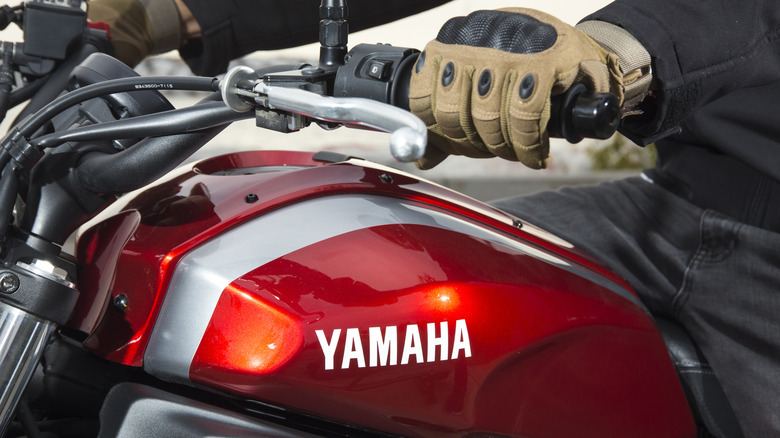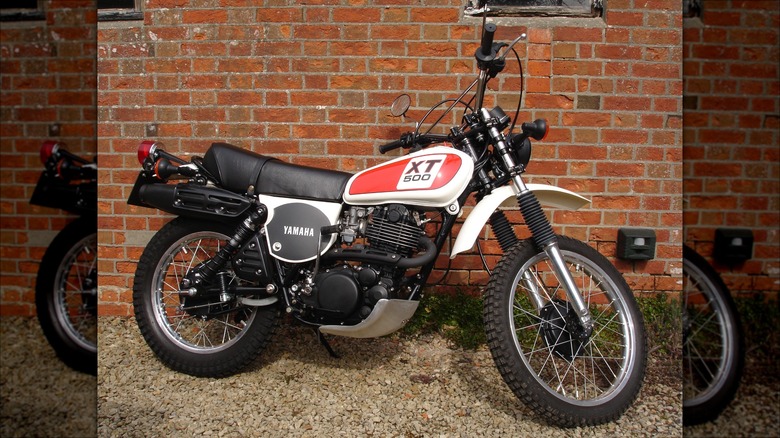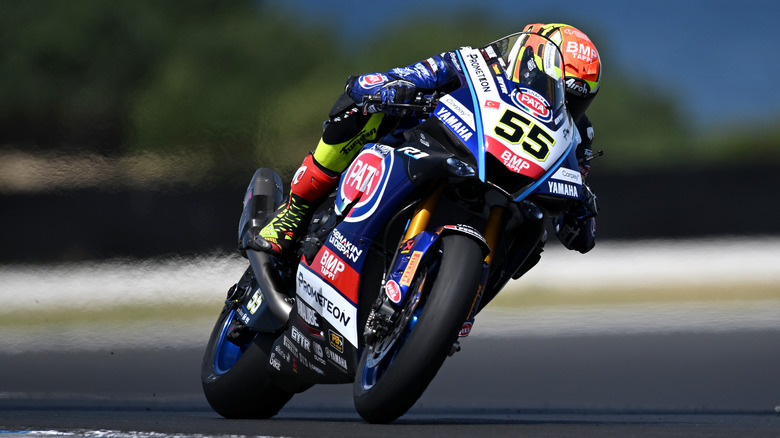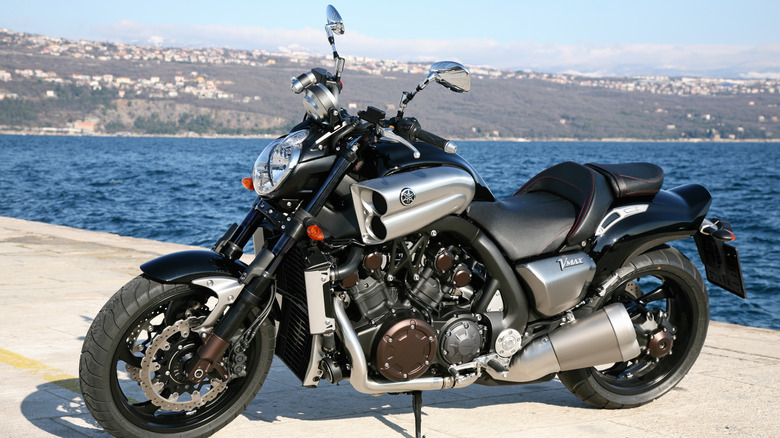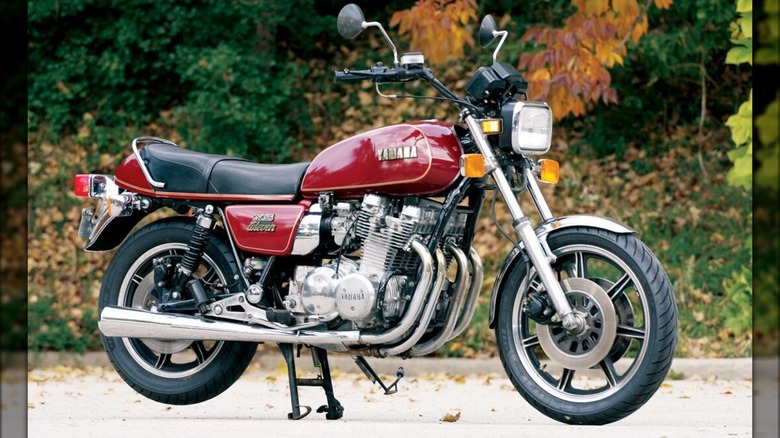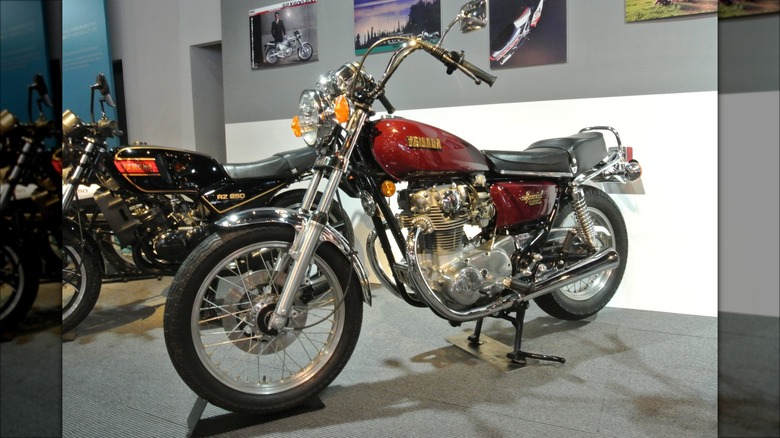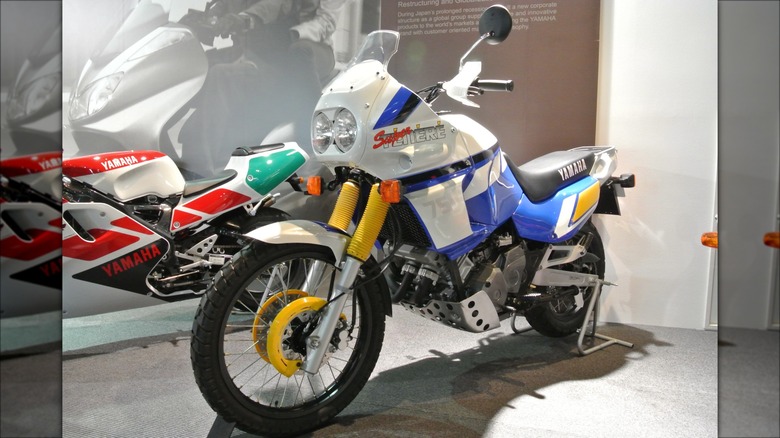6 Of The Most Reliable Yamaha Motorcycles Ever Built
What does it mean for a bike to be reliable? Essentially, it means that it consistently performs well. It covers everything from the engine's endurance to the durability of the bike's components. It means that the motorcycle runs as expected, day in and day out, without unwelcome surprises that could lead to downtime or, worse, compromise safety. It also means fewer visits to the mechanic, less money spent on repairs, and more time enjoying the ride. Reliability translates to longevity as well — reliable motorcycles maintain their functionality and often their value over years, or even decades, of use. And Yamaha, out of all motorcycle brands, has become almost synonymous with reliable motorcycles.
In a 2015 Consumer Reports survey of over 11,000 motorcycle owners, Yamaha ranked highest in reliability, with only 11% of its motorcycles experiencing a breakdown within their first four years. In contrast, Kawasaki had a 15% failure rate, while Harley-Davidson experienced a 26% rate of failure during the same period. The company has been making bikes for a long time, and Yamaha motorcycles have evolved over the years. These are the six Yamaha bikes that we think are the most reliable — some of which even made it onto our list of the most reliable motorcycles ever built.
Yamaha XT500
The Yamaha XT500 first proved its reliability by clinching victory in the inaugural cross-desert Paris-Dakar Rally three years after the bike was introduced in 1976. Powered by a 499cc (30.5 cu-in) air-cooled single-cylinder engine, the XT500's mechanical simplicity is a key aspect of its reliability. Its engine, shared with the SR500 street bike and TT500 off-roader, features a single overhead cam and two valves, delivering power through a 5-speed gearbox and chain drive to the rear wheel. This was a bike competing in some of the most difficult endurance races in the world, so the XT500 came with a frame built for resilience and a design that performs well both on and off-road.
Reliability isn't just a feature for the XT500 either; it's an intrinsic quality. The bike's straightforward, no-frills design means that when issues do arise, they're generally manageable. Its well-built construction, generous ground clearance, and protective bash plate mean it can handle rough terrain with few problems. The XT500 is known to be very reliable, but the motorcycle isn't without its quirks. The absence of an electric start means riders need a bit of muscle to get going — great news for purists, but not so much for those who prefer more convenience. Also, while it's great on roads and dirt paths, its heft and power delivery can make it a handful in more technical off-road scenarios.
Yamaha YZF-R1
The Yamaha YZF-R1 is known for being the motorcycle that took sports bikes to the next level. Yamaha began brainstorming the YZF-R1 in early 1996, aiming to outdo their just-launched YZF1000R Thunderace as well as competitors like Honda's FireBlade. They did this with innovations to the engine design, including a vertically stacked transmission and a narrower engine, which allowed for better weight distribution and a more stable ride. When launched in 1998, it was lighter and more powerful than its rivals.
Reliability starts with the engine, and more recent R1 models come with a refined cross-plane crankshaft inline-four engine and impressive specs that include a 998cc (60.9 cu-in) displacement, a power output of 197 hp at 13,500 rpm, and a torque of 112.4 Nm at 11,500 rpm. It's complemented by some advanced tech, including chip-controlled throttle and intake, too. According to reviews, the chassis and suspension systems are equally sophisticated.
MCN rates both the engine and reliability of this bike as 5 out of 5, and stories of R1 motorcycles surpassing the 100,000-mile mark with minimal issues are not uncommon in sportsbike forums. This is likely because the R1 is a flagship bike for Yamaha and is made with extremely durable materials and design. However, potential and current owners should be aware of some known issues, such as oil consumption, transmission glitches, and the occasional electronic hiccup.
Yamaha V-Max
The V-Max saga began in the 1980s when Yamaha introduced this powerhouse of a bike, and created a new motorcycle genre — the "power cruiser" — which later became known as one of the best Yamaha motorcycles ever made. The V-Max was influenced by the American market's fascination with acceleration and distinctive styling — and this is what the original 1985 model that won "Bike Of The Year" from Cycle Guide offered. It stood out with its muscle car-inspired design, powerful V4 engine, and groundbreaking V-Boost technology, and it continues to be loved long after its heyday.
The 2009 version of the V-Max, known as the Star VMAX in some markets, expanded its power cruiser credentials with a potent 1679 cc engine, producing an impressive 200 hp at 9,000 rpm. Notably, the bike also featured some of the same advanced ride-by-wire electronics as the R1. Despite the heavy specs, tech, and weight, the 2009 V-Max typically comes up in conversations about reliable Yamahas, too.
The V-Max had very few significant issues reported by users, and that's usually attributed to the "bulletproof quality" of these bikes. In fact, owners' reviews on MCN rate the reliability and build quality of the bike at an average of 4.3 stars out of 5, while the engine gets all 5 stars out of 5. However, potential buyers should keep in mind some problems, such as occasional shaft drive leaks, and be aware that tire choices are limited due to the bike's 18-inch wheels.
Yamaha XS1100
Back in the late '70s and early '80s, there was huge competition among Japanese motorcycle brands trying to outdo each other in power. Yamaha was right in the middle of this with a special bike called the XS1100 — also known as "the Eleven" for its 11-second quarter mile. This bike was all about going fast and being comfortable on long rides.
The Eleven's air-cooled, four-stroke transverse four-cylinder engine comes as a 1101cc (67.2 cu-in) unit. It also had transistor-controlled ignition, wet sump lubrication, and a HY-VO chain and gear for primary reduction. All this ultimately translated to 95 hp at 8500 rpm, pushing the bike to a top speed of 126 mph. The shaft drive, in particular, is a big factor in the bike's reliability and reduced maintenance.
The XS1100's reputation for reliability also comes from the fact that it won some pretty intense endurance competitions like the Castrol Six Hours. That being said, the motorcycle is not without its quirks. The bike's hefty build can affect maneuverability and handling, especially at high speeds. Another known issue with the XS1100 involves the second gear, which can jump out due to excessive torque application — this says something about the bike's potent engine but is also a big point of caution for owners since the only option is to visit a mechanic, disassemble parts of the engine to reach the transmission, and get it fixed.
Yamaha XS650
This is a motorcycle with deep roots that trace back to the close of World War II. The XS650's story began with Germany's Horex and its parallel-twin engine, which, through a series of acquisitions, found its way into Yamaha's hands. This fusion of German design and Japanese refinement resulted in a motorcycle that not only rivaled but, in many cases, surpassed its British counterparts, especially in terms of reliability.
Launched in 1968, the Yamaha XS650 showcased a 653cc (39.8 cu-in) four-stroke, parallel twin engine characterized by its unique 360-degree crank and a horizontally split crankcase — a departure from the then-common vertically split designs. This improved the bike's performance and significantly reduced oil leaks, which were a common issue with motorcycles of that era. Its construction, coupled with a simple yet effective air-cooling system, also went a long way toward making the XS650 one of the most reliable motorcycles to come out of Asia.
With a power output of 53 hp at 7,200 rpm and a torque of 54 Nm at 6,800 rpm, XS650 owners had a spirited ride on a machine capable of topping the coveted 'ton' — 100 mph (remember that this is a bike from the '60s). Its frame, complemented by telescopic forks upfront and dual shock absorbers at the rear, alongside a single disc for the front brake and a drum at the rear, also contributed to the Yamaha's durability.
Yamaha XTZ750 Super Tenere
Like many motorcycle manufacturers that proved the reliability of their models in the dirt, the Yamaha Super Tenere also has chapters in its history competing in the Paris-Dakar Rally. The Super Tenere is powered by a 749cc (45.7 cu-in) parallel twin engine, which delivers 69.3 horsepower and 68 Nm of torque, and a 5-speed transmission. The motor is housed in a sturdy steel frame, complemented by telescopic forks and an adjustable mono-shock rear. The bike's liquid cooling system, twin-disc front brakes, and generous 26-liter (6.6-gallon) fuel tank add to its long-haul readiness.
While the specs might interest enthusiasts, what's important is reliability, and thanks to the tough design and the use of proven Yamaha components, the Super Tenere does well in this regard, too — after all, the bike was built to enter the Dakar rally. The bike also receives a lot of praise from owners because of its durable chassis and the hardiness of its parallel twin engine. Some owners on MCN even report that they've logged more than 60,000 miles on the bike without any issues. Interestingly, MCN owner's reviews rate the bike 4.7 out of 5 stars, but MCN themselves score reliability at a neutral 3. It's difficult to say that it's a truly unfair rating because, based on reviews, there is still room for improvement on the Super Tenere — however these complaints are mostly concerned with trim. Regardless, its reputation for dependability is kind of set in stone by the lack of major breakdowns and the availability of parts.
